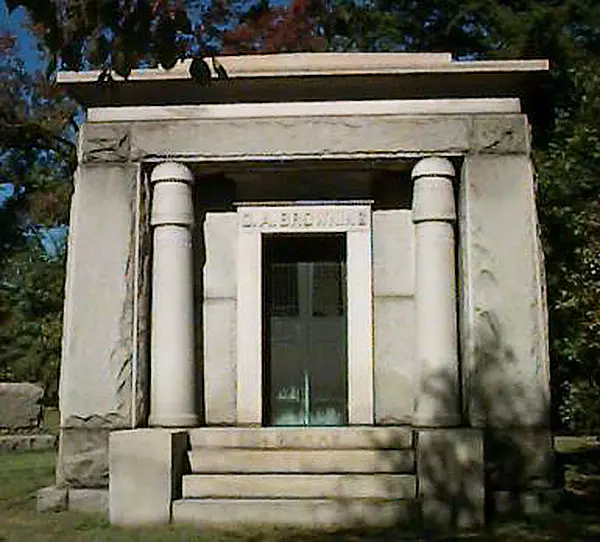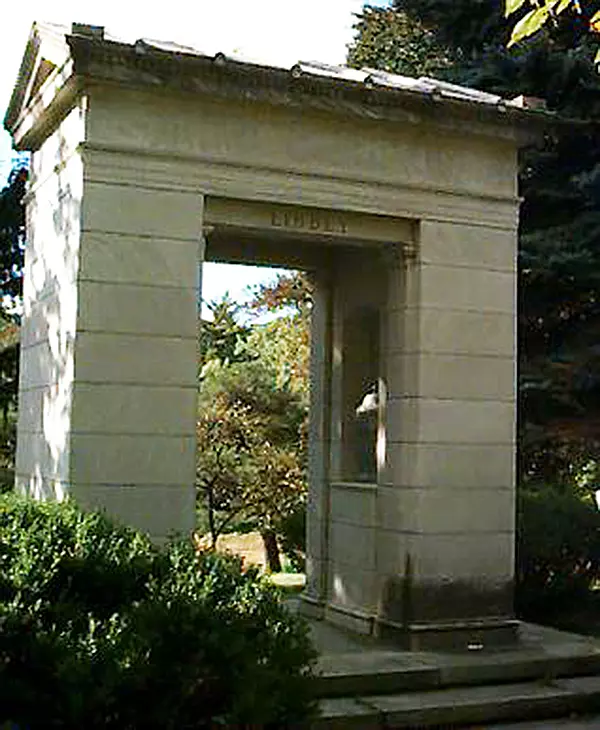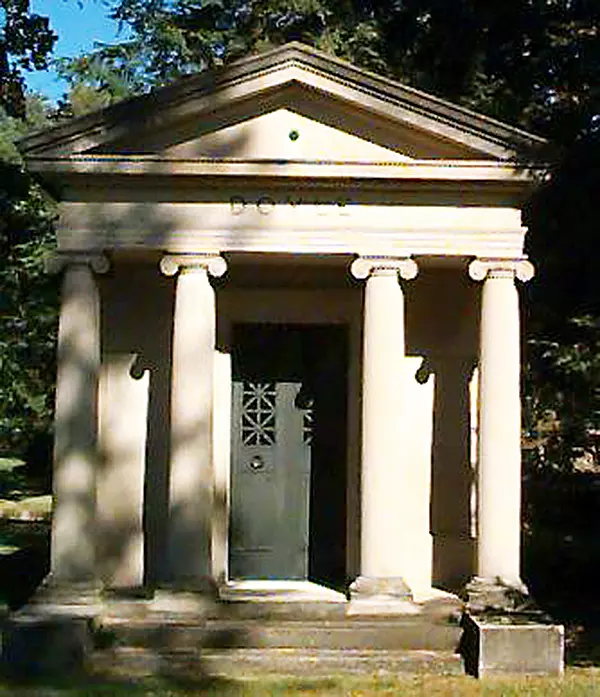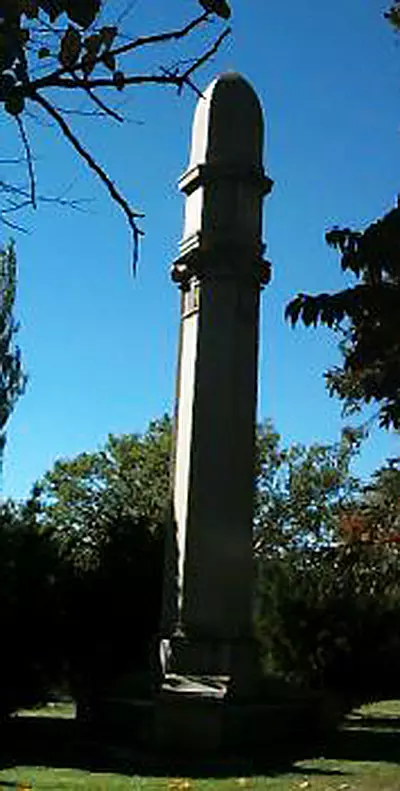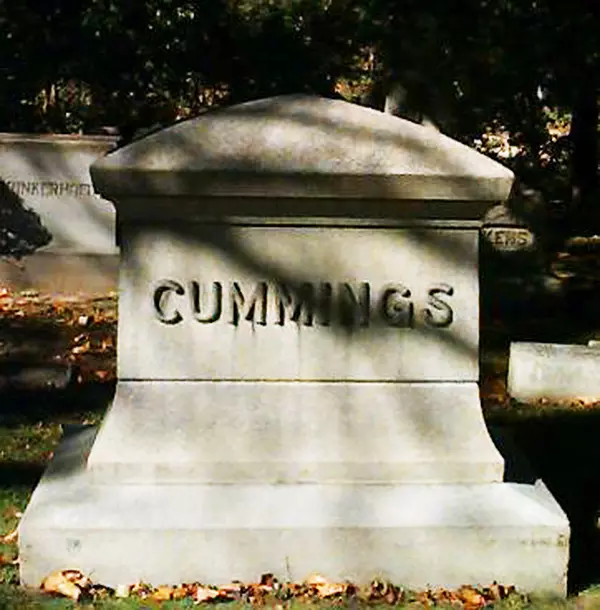Toledo's Woodlawn Cemetery
From "Notes from the Editors" by Charles N. Glaab. Northwest Ohio Quarterly, Winter 1996
The subject of this issue-the history of cemeteries in Northwest Ohio-presents an opportunity for more tranquil observations than our editorial comments of late on the current "war against history." But perhaps not entirely. Much of the rancorous debate on the effort to establish national standards for the teaching of history or for exhibits on the Enola Gay, Sigmund Freud and slave life assumes the existence of an irrefutable body of historical knowledge that can be uncovered by trained historical scholars to produce a true conclusion-perhaps not a scientific truth but something nearly so. But this is not the history we seek when we visit a cemetery. The single-minded analysis that is a part of contemporary debate overemphasizes the unity of historical knowledge. In his famous critical essay, "The Use and Abuse of History," Frederick Nietzsche pointed out that history exists at different levels of comprehension, all of which have a measure of validity -or in his view, more exactly, a lack of validity. Among these are the "antiquarian," which connects an individual with a place and creates the impulse to survey "the marvelous individual life of the past" and identify oneself "with the spirit of the house, the family, and the city." For the individual the "history of the town becomes the history of himself." 1
It is ordinarily this antiquarian imperative that impels people to visit country graveyards, the remaining burial grounds in our cities and the modern cemeteries of recent times-to observe the tombs of the famous, and to wonder at the creativity of monuments to death. The antiquarian impulse strengthens, of course, with age. The young fear the graveyard, as they experience the first shudder of mortality. The japery imposed on every child who grew up in a small town-"I went out to the cemetery today; I saw everyone I know there"-acquires new dimensions as years pass. But a visit to a graveyard seldom evokes a sense of one kind of historical reality, that the mountebank and the reprobate, the cruel and the avaricious-the villains who fill our academic histories-lie there. More often, as Nietzsche observes, one simply "looks back to the origins of his existence with love and trust; through it he gives thanks for life." 2
Nietzsche’s antiquarian impulse, which takes many to the historical museum or historical site, or the graveyard, may be as much a mystical as a historical experience. When we visit these places seeking historical dimensions, we seldom are searching for the historical truths of the academy. Nevertheless, a tour of the cemeteries of the Toledo region, some of which are portrayed in a photographic essay in this issue, provides a few obvious insights into historical forces that shaped American society. Notably demonstrated is the unity of Western civilization; there is little cultural diversity in the iconography of Christianity. Christ figures, cherubim and angelic hordes abound alongside the symbols of the civilization of Greece and Rome. The omnipresent obelisks and occasional pyramids represent part of a nineteenth-century cultural effort to tie Europe and America to ancient Egypt, the first civilization, it was thought, upon which had been built the civilization of Europe. The 20th-century temperament replaces ornate Victorian statuary with cubes and spheres and the occasional minimalist mausoleum, while a continual fascination with technology makes trains and airplanes the celestial omnibus. (The World Wide Cemetery on the Internet and laser sealing of durable pictorial images on tombstones represent the latest homage to technology in memorializing the dead. 3) In the latter years of the century, the traditional cemetery of monuments and statuary has often been succeeded by the ultimate in minimalism-the memorial park with acres of grass and occasional shrubbery, but with no raised tombs to disturb the sublimity of nature.
The cemeteries of the Toledo region are for the most part a product of the modern period of cemetery building-the era of the "rural cemetery" movement, which began in Europe and America in the early years of the nineteenth century. Before then the dead were interred in church burial grounds, producing such familiar reflections on death as those in Gray's "Elegy." One of the more moving passages in early American letters is to be found in the famous diary of Samuel Sewell, the Puritan magistrate instrumental in the hangings of Salem witches. The day after the sudden death of his two-year-old daughter Sarah on December 23, 1696, he laments his part in the Salem trials. On Christmas day, his entry records the events of the burial, the reading of Biblical passages by his three young surviving children and friends bearing "my little daughter to the Tomb." After a visit earlier in the day to the brick-lined excavation located in Boston's New (afterward the Granary) Burying Ground, he wrote: "Twas wholly dry, and I went to see in what order things were set; and there I was entertain'd with a view of, and converse with, the Coffins of my dear Old Father Hull, Mother Hull, Cousin Quinsey, and my Six Children: for the little posthumous was now took up and set in upon that that stands on John's: so are three, one upon another twice, on the bench at the end. My Mother ly's on a lower bench, at the end, with head to her Husband's head: and I order'd little Sarah to be set on her Grandmother's feet. 'Twas an awfull yet pleasing Treat: Having said, The Lord knows who shall be brought hether next, I came away." 4
In late-eighteenth-century Europe a new concern with the dead started a movement for large burial grounds in natural settings away from populous areas of cities. The use of the term "cemetery" (cimetière in French) instead of the more common Old English-derived word "graveyard" reflected in part an effort to relate death to the natural universe posited by Romanticism. The word cemetery came from the Greek word for sleeping chamber, a place of repose. The new model for the rural cemetery, Père la Chaise in Paris, opened in 1804 with hundreds of acres on the city's eastern outskirts. Its founding was the result of the 1765 Parliament of Paris decree that closed all cemeteries in the city and required the movement of corpses outside its limits. By the end of the first decade four rural cemeteries had been established around Paris, with Père la Chaise's plan for a vast, rustic, garden-like burial ground followed shortly in London, Genoa and Vienna. The new cemeteries became popular gathering places for lovers and families on Sunday promenades. 5
Within American cities, in particular New York, Philadelphia and Boston, early- nineteenth-century church burial grounds had become overcrowded and badly maintained, while the great demand for urban land forced the reburial of many. In addition, before midcentury when the germ theory of disease first began to gain credence, prevailing medical thought emphasized the dangers of disease-causing miasmas from contamination.
Public health authorities warned about exhalations arising from graveyards, while physicians argued that decaying corpses contributed to the devastating yellow fever epidemic of 1822. These influences, along with Romanticism's conception of nature's positive effect on mind and body, contributed to the movement for rural cemeteries in the United States.
The first American cemetery tied to this movement was Mount Auburn, established in 1831 on a seventy-two-acre site on the Charles River, four miles from Boston, an area described at its dedication as having "vigorous growth of forest trees" on land "beautifully undulating in its surface, containing a number of bold eminences, steep declivities, and shadowy valleys." 6 The quick success of Mount Auburn influenced leaders in other U.S. cities to establish rural burial grounds; it, Laurel Hill in Philadelphia (1835) and Greenwood in Brooklyn (1838) were the three cemeteries that influenced the national movement. In 1849, when Toledo was just beginning to grow as a city, Andrew Jackson Downing, popular advocate of nature in the early years of the century, declared, "There is scarcely a city of note in the whole country that has not its rural cemetery." 7 The establishment of this movement was related to the emergence of the urban park movement in the mid-nineteenth century. Early advocates of parks, such as popular nature poet and New York editor William Cullen Bryant, noted that urban dwellers were finding their way to the new cemeteries in large numbers. Nature's benefits to body and soul, he argued, should be brought to the city itself.
The two cemeteries represented in articles in this issue- Woodlawn in Toledo and Oak Grove in Bowling Green-represent well the characteristics of American rural cemeteries, as do many others in the region, in particular Wolfinger Cemetery in Secor Metropark and Swan Creek Cemetery, west of the city of Maumee on Highway A20 in Monclova Township. The former is enveloped by the metropolitan area's most naturalistic park setting, while the latter, although properly a church graveyard, seems to extend almost organically into a heavily wooded ravine with creek. Forest Cemetery, the oldest in the city of Toledo, contains the most elaborate statuary in the region and provides the most striking vistas of the natural park cemetery surrounded by a modern city. The iconography of Roman Catholicism in America is probably best represented in Calvary Cemetery. That cemetery is related to the effort to bring nature to the city through the establishment of parks (in this case nearby Ottawa Park) connected throughout the metropolis by tree-lined boulevards (in this case, Parkside Boulevard). There are also significant reflections of the past in smaller sites such as Haughton Cemetery, which is completely surrounded by the continuous strip mall of the business section of West Toledo. Most motorists would scarcely notice it, although children from a neighboring school continue to visit it yearly as part of the formal observances of our sole important pagan holiday, Halloween. The modern cemetery can still provide the kind of haven it did in the early years of the nineteenth century. The popularity of bicycle touring in the latter part of this century, for example, has led to a rediscovery of the cemetery as the "charming pleasure-ground" of which Downing spoke. A splendid guide to the back roads of Ohio for bicycle touring, published in various editions by Jeff and Nadean Disbato Traylor under the series title of "Life in the Slow Lane," identifies many of the state's most attractive cemeteries. 8 One of this writer's favorites from the guide is the 1808 Hopewell Church Cemetery, located south of West Florence and Highway 22 on Fairhaven Road, with its unusually attractive stone wall fronting the site. Not listed in their work is the Auglaize Church of God Cemetery near Fort Brown and the town of Grover Hill, which provides a tranquil bird watching spot and in the summer the near certainty of seeing groups of deer in the field and woods that encapsulate the small grave site that runs alongside a flowing creek. Harrington Cemetery in the heart of the town of Elmore, surrounded by wrought iron fencing, contains splendid grave markers from the early nineteenth century. St. Elizabeth Cemetery, to the west of Toledo, and Oak Hill on the southern edge of the metropolitan area are two of the scores of cemeteries that provide tiny natural havens from the mile upon mile of flat cultivated farmland that make up the region.
Perhaps this special issue of the Quarterly will not only stimulate interest in the historical significance of American cemeteries but also create some awareness of the neglected fact that cemeteries in this region and elsewhere preserve in part a natural world that we seem to be losing in modern metropolitan America.
NOTES:
1 Quoted in Michael Kammen, Selvages & Biases: The Fabric of History in American Culture (Ithaca: Cornell University Press, 1987), 162.
2 Quoted in ibid., l62.
3 The Detroit News and Free Press, 27 May 1996.
4 M. Halsey Thomas, The Diary of Samuel Sewell, 1674-1729, 2 vols. (New York: Farrar, Straus and Giroux, l973), 1:364.
5 For a concise discussion of the origins of the rural cemetery movement in Europe and America, see David Schuyler, The New Urban Landscape: The Redefinition of City Form in Nineteenth-Century America (Baltimore: The Johns Hopkins University Press, 1986), 37-56.
6 Quoted in ibid., 43.
7 Quoted in ibid., 47.
8 Life in the Slow Lane: Fifty Backroad Tours of Ohio, rev. ed. (Columbus: Backroad Chronicles, 1992).

